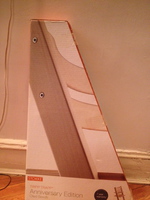So a publicist sent me [1] a Nintendo DSi the other day, which I still haven't opened yet. Though I'm a video game culture guy, I'm not really a video game guy. And I try to be upfront with the game folks, letting them know my reservations about the appropriateness of screen games for the site's zygote-to-preschool demographic. Kids that age, I say, why they'd be just as happy playing with a cardboard box.
And damned if the Nintendo folks didn't pack the DSi in the awesomest cardboard box K2 has ever seen. Spotlights, a hearty round of applause, and a mirror; what more could any 1-year-old ask for?
[1] Nintendo Guys and I have talked before, but I really discourage unsolicited samples and freebies [2] here at Daddy Types, both in the interest of editorial integrity and because it creates clutter, and then I have to be the one having to drive perfectly usable but unwanted stuff to Goodwill.
[2] This obviously does not apply to a 2009 Mercedes B200 Turbo with Mountain Grey metallic paint, Alpaca leather interior, and manufacturer certification of its US-DOT and EPA compliance. A-P-P-E-L-E-Z M-O-I, Mercedes Canada!





Is this where we should start begging?
Sorry, but I have to disagree with you. Kids 5 years and younger learn things through repetition. They learn that when you do certain things, certain things happen. While there is nothing wrong with giving them cardboard boxes (they'll learn about the properties of cardboard), you cannot teach them more abstract things like alphabets, numbers, colors, and words by giving them static objects. Books are the most common methods for teaching these things, but they are too static and passive, and always require parents to read them. When kids do something to a book, what they learn is the material properties of the book (i.e. paper); not its content. Electronic toys, especially the ones with touch screens, have a big advantage over these static toys. Kids are able to play with it on their own, and they have the dimensions of time, motion, and sound. So, they can be programmed to teach more abstract concepts through repetition and cause-and-effect.
Sorry, but this concept of "static" and "passive" is crap and generally refuted by the developmental literature. it's not that books "require" parents; parents are the entire point. Kids at that age learn through interaction, not through conditioned response. "Interactive" electronic toys end up being no more educational than a chicken trained to play tic-tac-toe.
Which is why I brought up the cardboard box issue at all. I'm all for kids grasping the ephemerality of pixels as much as the materiality of cardboard, but the Nintendo box is actually an "interactive" toy that lights up and gives an automated, simulated human reaction, the kind of "good job!" feedback that parents get sick of after the first hundred times. So yeah, I'm turning my kid into a chicken, but she's loving it.
My 3 year old "reads" to herself. For long periods of time. She's doing this from memory, but still...
We don't watch TV or play videogames in front of my daughter. The times she has wandered in she's watched for a few seconds and then wandered off. Up until a certain age you really do have to train them to be interested in this stuff.
We learned this the hard way when both my wife and I were horribly sick. We had saved watching TV for just such an occasion. We plopped our daughter down in front of it and watched in dismay as 15 minutes later she wandered off and started moving the entire contents of her bedroom into the living room.
I'm reading her "Henry and Ribsy" by Beverly Cleary right now (at her request), and I'm amazed by how much she actually understands. I should say that I don't think my kid is in any way exceptional. It's just we sell our kids short in so many ways.
Hey, what are the odds I can have that fancy-pants DSi box? I know somebody who would absolutely love it. =)
Greg,
Can you give me the references to "the developmental literature" that refutes this? Just by the sheer fact that we are adding the dimensions of time, sound, motion, and interaction would make a touchscreen device superior to books because it can always act as a static and passive book if it wants to. In other words, books only do a subset of what a touchscreen device can do.
Also, no one is arguing that parental interaction is a bad thing, nor that these devices could be a substitute for parental interaction. In fact, if the parent can play with the kid using a touchscreen device, it's certainly better than if the kid were to play by himself. BUT with a touchscreen device a kid has an OPTION to interact with it on his own if he wants to. It's like playing with a mechanical toy; you do something to it, and something happens (could move, make a sound, etc..).
Every object provides opportunities to learn different aspects this world. A cardboard box provides certain opportunities. A cat would provide its own opportunities. Water, bell, piano, wind-up toy, etc.. All these things provide different learning opportunities.
To say that a cardboard box can provide the same learning opportunities that a touchscreen device can, and to say that giving an object that provides different opportunities to a kid has no benefit, sounds rather difficult to believe. So, please do provide references to "the developmental literature".